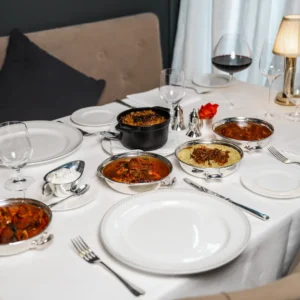Indian Gourmet Experience: The Richness of Fine Indian Food
The Indian gourmet experience stands out for its vibrant flavours, diverse ingredients, and rich culinary traditions. This article explores the richness of fine Indian food, highlighting its history, essential dishes, and cultural significance. With this guide, you will appreciate Indian food’s unique qualities and find joy in its many offerings.
The Essence of Indian Cuisine
A Blend of Flavours
Indian food not only offers a harmonious blend of spices and herbs, but each dish also carries a distinct taste that reflects regional influences. Moreover, the use of spices like cumin, coriander, and turmeric further adds depth and warmth. These ingredients create dishes that are not only delicious but also aromatic.
Regional Diversity
India is vast, and its culinary traditions reflect this diversity. Each region boasts unique ingredients and cooking methods. For example, Northern India often features rich, creamy dishes, while Southern India offers lighter, tangy fare. This regional variety enriches the overall experience of Indian cuisine.
Influences Through History
Historical events shaped Indian cuisine, introducing new ingredients and cooking techniques. The Mughal Empire, for instance, brought Persian influences that enriched North Indian dishes. Similarly, colonial interactions introduced various spices from around the world. These influences contributed to the evolution of Indian food into what it is today.
Essential Ingredients in Indian Cuisine
Spices: The Heart of Indian Food
Spices play a crucial role in Indian cooking. They enhance flavours and provide health benefits. Common spices include:
- Turmeric: Known for its anti-inflammatory properties.
- Cumin: Adds a warm, earthy flavour.
- Garam Masala: A blend of spices that enhances the taste of many dishes.
Fresh Ingredients
Fresh ingredients are vital in Indian cooking. Vegetables, legumes, and meats are often sourced locally. Seasonal produce ensures that dishes remain flavourful and nutritious. For instance, winter brings a bounty of fresh greens, while summer offers an array of fruits.
Aromatic Herbs
Herbs like coriander and mint add freshness to Indian dishes. They provide a vibrant contrast to the spices used. These herbs not only enhance flavour but also contribute to the dish’s visual appeal.
Popular Indian Dishes to Try
Curries: A Must-Try
Curries are a staple of Indian cuisine. They vary in flavour, colour, and texture. Here are a few notable examples:
For instance, Butter Chicken is a rich, creamy curry made with marinated chicken. Similarly, Palak Paneer is a vegetarian dish featuring spinach and cheese in a spiced sauce. Additionally, Lamb Rogan Josh is a fragrant curry made with tender lamb and aromatic spices.
Breads and Rice
Indian meals often include various breads and rice. Naan and roti are popular types of bread, perfect for scooping up curries. Basmati rice, known for its fragrance, pairs well with many dishes.
Street Food Delights
Indian street food offers a glimpse into the country’s vibrant culinary scene. Popular options include:
- Pani Puri: Crispy shells filled with spiced water and potatoes.
- Samosas: Deep-fried pastries stuffed with spiced potatoes or meat.
- Chaat: A tangy snack made with potatoes, chickpeas, and spices.
Indian Gourmet Experience: The Role of Indian Food in Culture
A Culinary Tradition
Food plays a significant role in Indian culture. It brings people together during celebrations and family gatherings. Cooking and sharing meals foster connections and strengthen bonds.
Festivals and Food
Festivals in India often feature special dishes. For example, Diwali celebrations include sweets like Gulab Jamun and Ladoo. These traditional foods hold cultural significance and celebrate community.
The Art of Sharing
Firstly, sharing food is a fundamental aspect of Indian hospitality. Furthermore, offering guests a meal signifies respect and friendship. Ultimately, this practice enhances the overall experience of enjoying Indian cuisine.
Fine Dining: Experiencing Indian Cuisine
Upscale Indian Restaurants
In addition, fine dining establishments offer an elevated experience of Indian food. They often blend traditional recipes with modern techniques, creating a perfect balance. Consequently, diners can expect beautifully presented dishes made with high-quality ingredients.
Tasting Menus
Additionally, many upscale restaurants offer tasting menus that showcase a variety of dishes. As a result, this allows guests to sample multiple flavours and textures in one meal. Furthermore, tasting menus often highlight seasonal ingredients and chef specials, providing a unique dining experience.
Wine Pairing
Pairing wine with Indian food can enhance the dining experience. While traditionally paired with beer or cocktails, certain wines complement the flavours of Indian dishes well. For example, a crisp white wine may balance spicy curries, while a robust red can stand up to rich meats.
Indian Gourmet Experience: Cooking Indian Food at Home
Essential Cooking Techniques
Cooking Indian food at home can be rewarding. Familiarising yourself with essential techniques is a great start. Some techniques include:
First, tempering involves heating spices in oil to release their flavours. Next, braising refers to cooking meat slowly in a spiced sauce for tenderness. Finally, steaming is a healthy method for cooking rice and vegetables.
Simple Recipes to Try
Starting with simple recipes can build your confidence. Here are a few beginner-friendly options:
For example, Vegetable Curry is a quick dish using seasonal vegetables and spices. In addition, Chickpea Salad offers a refreshing mix of chickpeas, herbs, and lemon juice. Lastly, Rice Pudding is a sweet dessert made with rice, milk, and cardamom.
Tips for Success
To succeed in cooking Indian food, consider these tips:
To begin with, mise en place involves preparing and organising your ingredients before cooking. Additionally, don’t be afraid to experiment with spices and adjust spice levels to suit your taste. Finally, practice patience by allowing flavours to meld through proper simmering of dishes.
Indian Gourmet Experience: Conclusion
In conclusion, discovering the richness of fine Indian food opens a world of flavours, traditions, and experiences. Moreover, by exploring its diverse offerings, you can appreciate the culinary artistry behind every dish. Whether dining out or cooking at home, Indian cuisine offers something for everyone. Embrace the journey of tasting and creating, and savour the delightful richness of Indian food.

